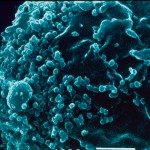Link to Pubmed [PMID] – 10438843
J. Virol. 1999 Sep;73(9):7533-42
This work aims at identifying the thymocyte subpopulation able to support human immunodeficiency virus (HIV) replication under the biological stimuli of the thymic microenvironment. In this report we demonstrate that interaction with thymic epithelial cells (TEC) induces a high-level replication of the T-tropic primary isolate HIV-1(B-LAIp) exclusively in the mature CD4(+) CD8(-) CD3(+) thymocytes. Tumor necrosis factor (TNF) and interleukin-7 (IL-7), secreted during this interaction, are critical cytokines for HIV long terminal repeat transactivation through NF-kappaB-dependent activation. TNF is the major inducer of NF-kappaB and particularly of the p50-p65 complex, whereas IL-7 acts as a cofactor by sustaining the expression of the p75 TNF receptor. The requirement for TNF is further confirmed by the observation that the inability of the intermediate CD4(+) CD8(-) CD3(-) thymocytes to replicate the virus is associated with a defect in TNF production during their interaction with TEC and correlates with the absence of nuclear NF-kappaB activity in these freshly isolated thymocytes. Addition of exogenous TNF to the intermediate thymocyte cultures induces NF-kappaB activity and is sufficient to promote HIV replication in the cocultures with TEC. The other major subpopulation expressing the CD4 receptor, namely, the double-positive (DP) CD4(+) CD8(+) CD3(+/-) thymocytes, despite the entry of the virus, do not produce a significant level of virus, presumably because they are unresponsive to TNF and IL-7. Together, these data suggest that in vivo, despite an efficient entry of the virus in all the CD4(+) subpopulations, a high viral load may be generated exclusively within the mature CD4(+) CD8(-) CD3(+) subset of thymocytes. However, under conditions of inflammatory response after infection, TNF might also be present in the intermediate thymocyte compartment, leading to efficient HIV replication in these cells.

